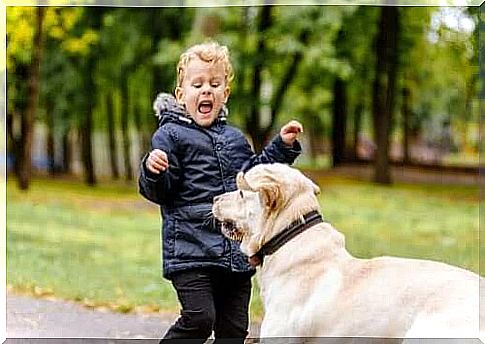What Should Be Done If A Child Is Afraid Of Animals?

Not all children treat a dog or other pet in the same way. Some like to iron them and are very interested in them. Others, on the other hand, prefer to stay away as an indication that they are afraid of animals. There is no single specific reason for this. Sometimes the fear may be due to a previous bad experience or to the fact that the child has been taught that a foreign animal can be dangerous. There are also children who are simply timid about the strange appearance of an animal. What can we do if a child is afraid of animals?
“Some children are more active and adventurous, while others are calmer and less open to new experiences. The latter feel more stressed when faced with a new and strange situation, ”says Dr. Tracy Dennis from Hunter College’s Department of Psychology.
Although fear is a defense mechanism that keeps children safe, they should be taught to respect animals and remember to be careful with them rather than to fear them, as fear prevents them from enjoying rewarding experiences with animals.
What to do if a child is afraid of animals?
Here are some tips to help parents help their children take that step from fear to respect.
Try to understand the child’s fear

Fear is irrational. It is therefore pointless to force a child not to be afraid of animals.
It is best to try to understand the cause of the fear and look for a strategy to deal with the fear. For example, if your child is afraid of a dog because of its size, do not suggest that he approach a big dog. When you are with a small and friendly dog, approach it yourself first and then encourage your child to do the same in your safety.
Teach the child to approach the animal
Children may approach the animal clumsily or too eagerly and frighten it. This usually causes an aggressive reaction in the animal, which then scares the child even more.
It is best to guide the child through each step and choose their words carefully. You should not use warnings such as “Be careful not to bite” or “Don’t get too close as it can be dangerous”. Use positive reinforcement such as “Approach the animal gently” or “Be kind to the animal”.
Start by teaching the child that the owner must always be asked for permission before the animal is approached. The animal should then be allowed to sniff the child’s hand before stroking. Both dogs and cats are more confident after sniffing the smell of a new person first.
Try to distract the animal by stroking its face. Then instruct the child to touch the animal from the other side, not preferably the tail, so that the animal is not frightened. The face of an animal can scare a child.
Avoid puppies if your child is afraid of animals

Animal puppies are more unpredictable than adult individuals. For puppies, play can be biting, scratching, or jumping on people. What can be a gesture of trust, joy, and love for an animal can seem like a hostile gesture to a child.
Learn the language of animals
Pets have their own way of communicating with people. Learning and teaching that language to a child can make the encounter easier.
Linda Case, author of Canine and Feline Behavior and Training: A Complete Guide to Understanding Our Two Best Friends , states that “an open mouth with lips retracted, tongue out, and a face relaxed is an invitation to interact”.
Teach your child to work with animals

Like puppies, children are unpredictable. That fear can turn into excitement once the first encounter with the animal has gone smoothly. The activities of an enthusiastic child may frighten or disturb the animal. Explain to the child that the animal should not be pushed, the fur should not be pulled and the tail should not be held.
Do not bring a pet home if the child is afraid of animals
Many parents believe it is a good idea to get a pet home if the child is afraid of animals. It may be that over time a child and a pet get used to each other, but it takes many days of unnecessary stress.
Wait until the child is ready. Some people keep a pet in one room until the child begins to trust it, but this too is not recommended. As a result, a pet can become aggressive as it learns that it is not its job to be social.









